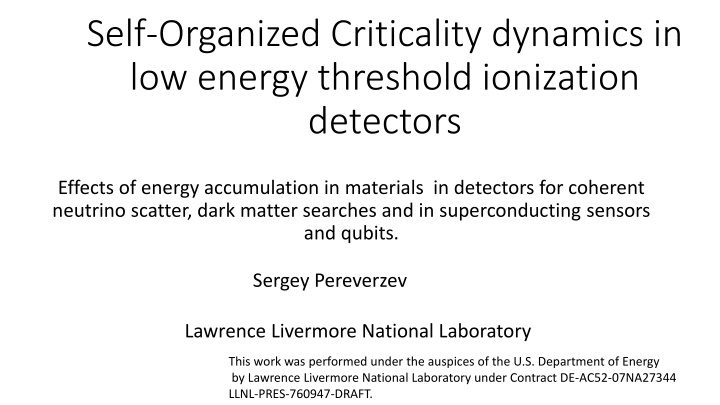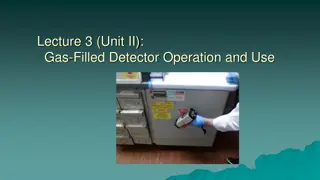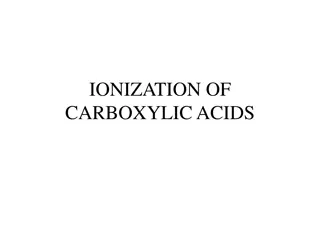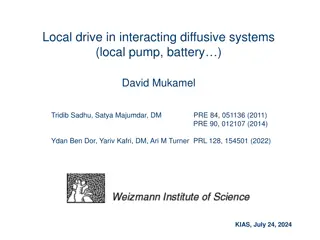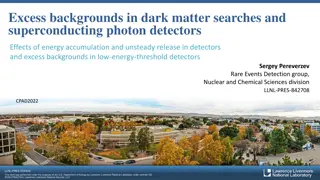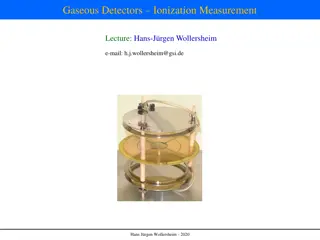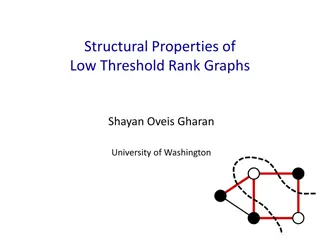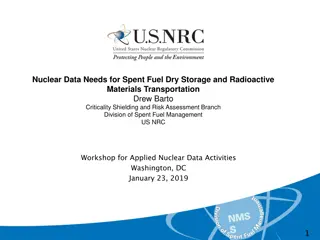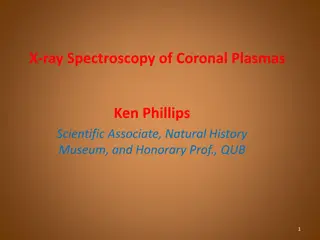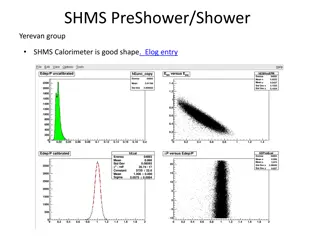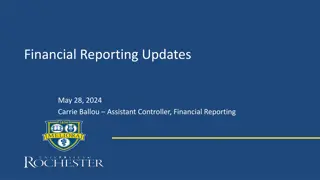Investigation of Self-Organized Criticality Dynamics in Low Energy Threshold Ionization Detectors
Exploring the effects of energy accumulation in materials in detectors for coherent neutrino scatter, dark matter searches, and superconducting sensors and qubits. Focus on condensed matter effects, responsivity, background, and a hypothesized universal condensed matter mechanism. Touches on energy accumulation in materials under irradiation and thermally stimulated luminescence. This study aims to enhance understanding and improve engineering in low-energy interactions and detector development.
Download Presentation

Please find below an Image/Link to download the presentation.
The content on the website is provided AS IS for your information and personal use only. It may not be sold, licensed, or shared on other websites without obtaining consent from the author.If you encounter any issues during the download, it is possible that the publisher has removed the file from their server.
You are allowed to download the files provided on this website for personal or commercial use, subject to the condition that they are used lawfully. All files are the property of their respective owners.
The content on the website is provided AS IS for your information and personal use only. It may not be sold, licensed, or shared on other websites without obtaining consent from the author.
E N D
Presentation Transcript
Self-Organized Criticality dynamics in low energy threshold ionization detectors Effects of energy accumulation in materials in detectors for coherent neutrino scatter, dark matter searches and in superconducting sensors and qubits. Sergey Pereverzev Lawrence Livermore National Laboratory This work was performed under the auspices of the U.S. Department of Energy by Lawrence Livermore National Laboratory under Contract DE-AC52-07NA27344 LLNL-PRES-760947-DRAFT.
Condensed matter effects are important in low energy interactions and development cycle for detectors Design/engineering improvements High voltage problems Internal background element in the design cycle we implemented using LDRD Condensed matter physics Surface science * Our group has expertise in particles detectors and condensed matter physics and cryogenic engineering Our work connects naturally to important problems in condensed matter and surface physics 2
Responsivity and background In Xe detector low energy nuclear recoils produce measurable response (calibrated!) And , would we put reactor and detector deep underground, neutrinos coherent scattering likely can be measured! We still do not understand all mechanisms for low energy background In above- ground detectors this low energy background 3 -4 orders of magnitude larger than expected CEvNS signal from reactor Calibration; Livermore data Background spectrum above ground, small Xe detector in Moscow (prototype of Zeplin), courtesy of Dmitry Akimov Background: Xe100, Dark Cide 50 Many types of detectors have enough responsivity to detect CEvNS, but low energy background is not yet understood (or measured )
Universal condensed matter mechanism? We hypothesize that there is rather universal condensed matter mechanism producing background which is sharply rising at energies nearing excitations in detector material. It also leads to self-correlations- like multiple electron emission events. Xenon10 Silicon- thick CCD sensor dark counts (SENSEI experiment) DAMA-LIBRA NaI(Tl) CoGeNT Germanium
Energy accumulation in material under irradiation Thermally stimulated luminescence & electron emission in solid Xe (Ar) NaI(Tl) Radiation effects in atomic cryogenics solids, E.V. Savchenko et al, NIM B268, 2010 see also M.E. Fajardo and V.A. Apkarian, J.Chem.Phys. 87, 1988 Thermoluminescence in Gamma-Irradiated NaI(Tl) Crystals Nucl. Tracs, Vol.10, pp/107-110, 1985 Long (days) energy storage: Xe2+ /Ar2+ and O2- are involved (Savchenko et. al. 2010). Exciplex complexes Xe2+ X- can be produced in solid Xe dopped with halogens( X=Cl, Br, F ) which emit light and decay; but with 10-5 probability pair of trapped ions can be formed with long lifetime effect is called photolysis (Apkarian, 1988). Thermally stimulated conductivity is known for many semiconductors and dielectrics. Trapping of electrons and holes is known for Ge, and CDMS detector require periodical purge with light to liberate traps.
Important things about ion trapping Thermally stimulated luminescence and Exaelectron emission are very common for dielectrics crystals and films on metal substrate; thermally-induced conductivity is common for dielectrics and semiconductors. Potential barriers for de-trapping in common detector materials is small (below 0.05eV). Clustering of defects and impurities is common in solid materials (zone melting purification) Avalanche recombination is possible for trapped ions, especially for clusters i.e. lattice deformation/ phonons from one pair recombination de-trap another ion and so on. Small environmental changers (pressure , temperature) can trigger single events and avalanches Hot phonons produced by CEvNS of low energy (solar) neutrinos can cause de-trapping and avalanches! NB! quenching factor for low energy nuclear recoils can change in presence of high energy background
Scientific American, Vol 254, pp.46-53 (1991) Classical soft condensed matter example - grows of sand pile, when material is added to the top and spreads horizontally by avalanches. Applicable to hardcore condensed matter - crack formation, motion of quantized vortexes in superconductor, some interacting spin systems. Excitations are slowly produced, accumulate and annihilate in avalanche- like events. Important features of Self-Organized Criticality dynamics are universal and do not depend strongly on details of interactions:
SOC dynamic features Polynomial (not exponential) events spectrum- applicable to particles detectors; probability of a catastrophic event not negligible Looks familiar? Noise power spectrum close to 1/f (pink noise)- applicable to superconducting detectors (SQUIDs, TES, etc., qubits) Low energy particles/ events can cause large events (put sand pile on vibrating platform ) Suppression of large events by reinforcing relaxation at small scale- These features can help to identify the problem and mitigate unwonted effects. Microscopic models are required for excitations and their interactions
Main hypothesis Due to the small activation energy for charge de-trapping and due to the effects of clustered defects and impurities, in all materials where thermally stimulated luminescence, thermally stimulated electron emission, or thermally stimulated conductivity are present, the avalanche-like relaxation events that create bursts of electron- or photon-emission or bursts of conductivity will also be present.
Expansion of rare events searches ? Low energy event In the detector CEvNS of low energy solar neutrino could trigger avalanches New physics: while most common, Glasses are not well understood CEvNS events SOC dynamics Excitations in material Rare condensed matter events Dark matter particles Interactions beyond standard model 10
Scintillator NaI(Tl) detectors Ap Ap- -conversion for conversion for NaI NaI(Tl) is known: (Tl) is known: Saint-Gobain technical note : With mild UV exposure, several pulses per second can be seen in the 6-10 keV region of a spectrum. If the crystal is stored in a dark area, this mild UV exposure will eventually disappear, although it may take from several hours to several days for the effects to stop. Suppression of TSL by IR/ red light is known, suppression Suppression of TSL by IR/ red light is known, suppression of bursts after UV irradiation need to be checked of bursts after UV irradiation need to be checked. . Prediction: irradiation with red/ IR light should prevent energy accumulation and suppress effects from ionization load (muons), fluctuations of temperature and pressure, and solar neutrino flux, while not affect nuclear recoils caused by d dark matter particles. David Nygren, A testable conventional hypothesis for the DAMA-LIBRA annual modulation , >astro-ph > arXiv:1102.0815 (2011)
Dual Phase Xe and Ar detectors don t look don t tell RGS crystals: polynomial events spectra / up-conversion (bursts) in TSL and TSEE after irradiation / UV exposure -Not checked yet . Physiosorbed film of solid Xe and Ar ~8 monolayers are present on electrodes TSL and TSEE are imbedded into dual-phase detectors. Sanity check: irradiation of grids with UV light should produce tail of few-electrons events Anode grid Photo-multipliers (PMTs) Natural explanation for multiple (1,2,3, 8) electron events HV Gas secondary Extraction grid Effects of re-emission from liquid surface (incomplete extraction)and by electronegative impurities, ionization of impurities by S2 light (electroluminescence) are present. Liquid primary Radiation HV e- e- e- May appears at the same please after drift time delay due to ionizing impurity trapped electrons by native and following S2 pulses (to be checked for following!) Cathode grid Photo-multipliers (PMTs) S2 pulse also makes imprint by photolysis (ion pairs formation) in solid layer on extraction grid- decay / delays of this electron emission not related to electron drift time.
Xe/Ar dual-phase detectors high extraction field, high purity, high AC field on wires Remove TEFLON and plastics find Xeno-Fluoro-Carbons? Split HV cable inside the xenon vessel, apply AC signal - AC signal can come from transformer or appropriate power supply - Will most likely be a custom job - Have an electrical engineer do the design - Can test in small detectors via stability at higher potentials - Can test in full-scale detectors by (hopefully) enhanced electrostatic stability - Related signal: shorter time scale for e- trains by strong AC field (IR, microwave, ultrasound?) Quenching of excitations on electrodes Dark Matter detectors Grid A lead AC modulation removed electrode charging(hysteresis) in Helium experiments AC power supply or transformer LLNL data Grid B lead 1kV p-p at ~3 MHz HV 14 Electron emission background in Xe/Ar dual-phase detectors likely have other components- we are planning experiments in wide range of DC and AC fields to look for other mechanisms in condensed-matter style experiments; we also have windows for spectroscopy. arXiv 1911. 11580 SOC related background in Xe/Ar IS an example of general case- applicable to noise and decoherence in superconducting sensors and qubits- i.e. basic QI problem. Consistently large electron extraction efficiency and Electron drift velocity in high fields in absence of TEFLON
SOC dynamics and superconducting detectors & qubits? At low temperatures of system of interacting charges (on interfaces), spins (localized electrons, impurities, nuclei) , nuclear quadrupole moments, etc., are in glass-like state, so one can define a generalized excitation as any non-equilibrium configurations of this system. Time-varying electric or magnetic fields applied to materials can produce the generalized excitation. Example: CMB and IR photon detectors: <<< AC field drive intensity <<< Noise equivalent power energy sensitivity >>> MKIDs TES with SQUID array readout Superconducting nanowire Sensors are a parts of microwave resonant circuits Sensors separated from array of SQUIDs; SQUIDS included in resonators DC current in sensors while waiting for click RSFQ -compatible* SOC model an addition or an alternative to Tunneling Two-Level Systems model for noise /decoherence.
Conclusions More collaboration in between HEP and BES on detector physics is required Detection beyond standard model workshops need advances condensed matter sections Detector physicists need to present regular on condensed matter/ low temperature conferences Presence of condensed matter physicists on dark matter / interaction beyond standard model projects reviews Advanced condensed matte training for Students and post-docs in in the field
Energy accumulation in material under irradiation Thermally stimulated luminescence in NaI(Tl) and other alkali halides, Thermally stimulated conductivity and charges trapping in CDMS (germanium). Thermoluminescence is known for alkali metal halides; here no additional impurities is required; it is possible to suppress thermoluminescence by irradiation with red or IR light. Thermal luminescence in Al2O3(I) (personal dosimeters) can be suppressed by sunlight and by microwave exposure. Light or mechanical stress are known to induce UV luminescence or electron emission in many irradiated materials. Thermally stimulated conductivity is known for many semiconductors and dielectrics. Trapping of electrons and holes is known for Ge, and CDMS detector require periodical purge with light to liberate traps. Thermoluminescence in Gamma-Irradiated NaI(Tl) Crystals Nucl. Tracs, Vol.10, pp/107-110, 1985
